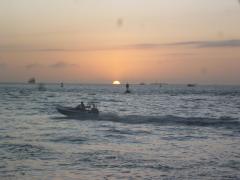- 2011-11-25 (Fri) 03:16
- Random thoughts
I’ve enjoyed the past weeks in New Orleans and then Key West. Both places looked to be very different from the rest of US I’ve visited so far. I guess that my itinerary of this journey was a wise one, although if you start from the West Coast, this would be the natural course of the American tour. Anyhow if I had started from these two cities, I might have found it difficult to continue with the incentive of the journey.
I visited New Orleans for Tennessee Williams. The playwright lived there for the later years of his life. His famous play, “A Streetcar Named Desire” is based in New Orleans. I wanted to see the actual streetcar named Desire. No it was not running any more with that particular name. Otherwise there were plenty of streetcars I could jump into with a $1.25 fare. Most of the streetcars I saw were very old and the fact made me feel more affinity to them somehow. I don’t know why. Maybe as you get older, whenever you see somebody or something very old but still active and functioning very well, you get an encouragement from them. The drivers were very accessible and if I told them of my destination, they would kindly tell me to where to get off.
You walk around the famed French Quarters. There seemed to be music all over the places there. The noise and the bustling of the Bourbon Street. At one time I hopped into a bar for a beer. It turned out to be a kind of a Karaoke type bar. It was around 4 pm on a weekday. A group of young girls were singing. I suppose that they were tourists like me. Then there were apparently some locals. All enjoyed singing in turn. I’ve enjoyed myself very much. I could take any photos of their singing without any worry. It would have been not so easy in other places. But that was New Orleans.

After New Orleans I proceeded to Key West for Ernest Hemingway. The weather was fantastic. It was very warm or more accurately still hot in November. It meant it was perfect time to swim in the sea. Key West is actually the most southern part of an archipelago called Florida Keys and an island of only 6 by 4 miles. I could rental a bike and ride it all around the island. Most of the times there were side roads for the bikes.
In Key West I read Hemingway’s book “The Old Man and the Sea” again, which I’ve bought in Oxford, MS. As it happens so often, it is a surprise and pleasure to find something new you haven’t noticed at all in the previous reading. While in this journey when I talked to people about Hemingway’s literature, some mentioned about his style of writing, the so-called “iceberg theory.” Some even mentioned that the writer might have been influenced by Japanese literary form of “haiku.”
The iceberg theory seems to have come from a passage in his another book “Death in the Afternoon.” He wrote; If a writer of prose knows enough about what he is writing about he may omit things that he knows and the reader, if the writer is writing truly enough, will have a feeling of those things as strongly as though the writer had stated them. The dignity of movement of an ice-berg is due to not only one-eighth of it being above water.
That is exactly the world of haiku, a Japanese poem consisting of seventeen syllables of 5, 7 and 5. Due to the limitation of the seventeen syllables, you have to omit wordiness. But you have to let other people understand what you are talking about. It is not an easy task. That is the reason I prefer another form of poem, called “tanka,” which permits two more lines, with 31 syllables of 5, 7, 5, 7 and 7.
When I came across the following sentence in “The Old Man and the Sea,” I thought of his haiku world. Hemingway is describing here the very last moment of the huge marlin the old man had struggled to kill for three days; Then the fish came alive, with his death in him, and rose high out of the water showing all his great length and width and all his power and his beauty.
By the way the haiku has to have one prerequisite word, “kigo” that implies a season. The readers would know what time of the year the haiku is made by a poet. Thus we have “saijiki,” a glossary of seasonal words for haiku. For example “cho” (butterfly) is a word of spring, whereas “semi” (cicada) is a word of summer. (No need for a kigo in tanka.) In all the year round warm island of Key West, it might be not so easy, I thought, to find an appropriate kigo for November, which resonates with the rest of the US.
(photo: a sunset in Key West)







